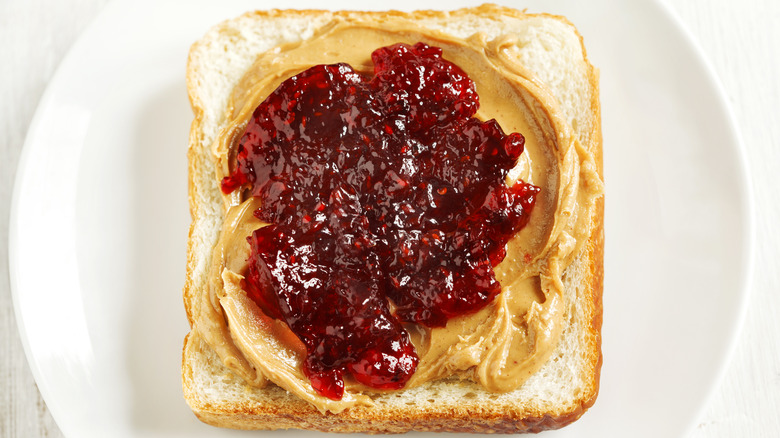Peanut Butter And Jelly Sandwiches Really Boomed After WWII
If you grew up eating peanut butter and jelly sandwiches, maybe you know what we mean when we say the three-ingredient snack has a primordial quality to it, as if it's been around since the creation of the universe. No matter how bare-bones (smooth Jiffy peanut butter, Smucker's strawberry jelly, and white bread) or bougie (a bespoke blend of tree nuts, seasonal jam from the farmers market, and homemade sourdough), the flavor and texture experience of every PB&J always exists on the same salty-sweet plane.
It might surprise you, then, given the sandwich's seemingly timeless nature, that it hasn't always been a mainstay in the lunchboxes of American schoolchildren. In fact, peanut butter and jelly didn't hit the lunchtime scene in the United States until the 1940s, when soldiers returned home from World War II. After plenty of experience with PB&Js when on duty, the soldiers then spread the secret of their favorite wartime snack to loved ones. Here's how military dining gave way to one of the country's most beloved foods.
A passion for rations
Kids aren't the only ones who love peanut butter and jelly sandwiches. According to the U.S. Army, the PB&J was a popular choice among soldiers fighting in both World Wars for its easy-to-find ingredients packed with protein and carbs. "Back in garrison, service members and their families need only visit their commissary to find the peanut butter, jelly, and bread they require for their pièce de résistance," said Marine Sgt. Maj. Michael R. Saucedo.
Troops didn't have access to all of their favorite foods once they shipped out (and meat was scarce), but by World War I, their rations included bread, creamy peanut butter, and jelly. Soldiers began combining the three ingredients to make the most of what they could find in the commissary. By the Second World War, PB&Js had a cult following among service members and were even offered pre-assembled on troops' menus. It wasn't until after World War II that the soldiers shared their secret snack with their families back home.
From currants to concord
Military men may have played a role in ushering peanut butter and jelly into fame, but they didn't invent it. They may have been inspired by the first-known recipe for the sandwich published by Julia Davis Chandler in a 1901 issue of the Boston Cooking School Magazine of Culinary Science and Domestic Economics. In it, she encourages readers to try the combination of currant or crab-apple jelly with peanut paste, which she claimed was "delicious, and, so far as I know, original," via What's Cooking America.
Crab apples and currants weren't exactly commercial fruits, so a grape jelly called Grapelade took precedence for camo-clad PB&J fans. When World War II soldiers returned to the States, they must have been particularly vocal about what they ate, because PB&Js soared in popularity. The sandwich has been reigning supreme ever since. According to a 2003 survey by the J.M. Smucker Company (via Prepared Foods), a typical American will have consumed around 1,500 PB&Js by the time they graduate from high school alone.


